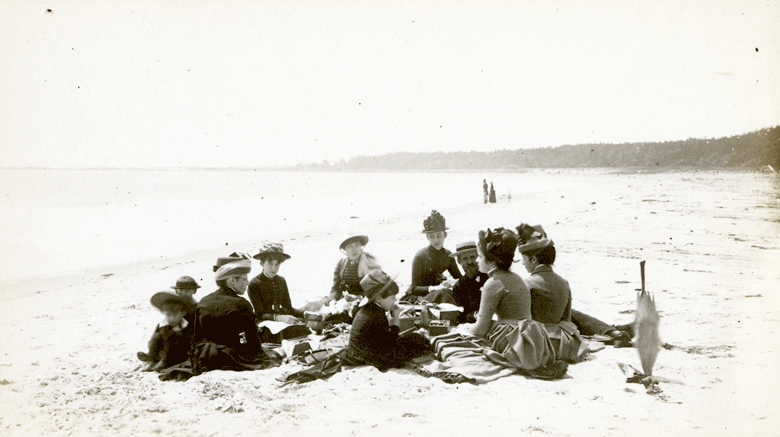The practice of beachgoing is more modern than one might expect. In fact, it wasn’t until the turn of the 19th century that a cultural appreciation for beachgoing gained solid footing in European society.
Popular medical texts touted the benefits of ocean air and dips in frigid waters. At the same time, industrialization made cities cramped and polluted, creating a longing for untouched nature.
Beginning in the 1860s, Americans adopted similar sentiments and customs as Northeastern cities industrialized. This “Rusticator Movement,” as it is commonly known, popularized Maine coastal communities as tourist destinations and is now a permanent way of life embodied in the state moniker “Vacationland.”
The photograph featured here is a group picnicking on what is now known as Popham Beach State Park in Phippsburg, in 1886. A nearby parasol sticking up from the sand is on standby to shield from the sun’s rays.
While it appears warm enough for a picnic in the sand, it is hard to tell if this is in the summer, as Victorian-era modesty usually trumped comfort. Bathing costumes were also cumbersome at this time, especially for women, as it involved being dressed from head to toe—save for exposed forearms.
The beach’s rise in popularity charted the same course as most societal trends…
While sunbathing and reasonable bathing suits had not yet caught on in 1886, similar scenes at Popham can be seen on any given summer day as it is the state’s highest volume day-use park. It saw nearly 63,000 visitors in July 2022.
Of Maine’s thousands of miles of coastline, only about 35 miles (less than 0.01%) feature sandy beaches like Popham. This is due to the geological processes required to make sand. South of Portland, much of the coast is oriented parallel to sea waves which provide optimal conditions for sand to come ashore. River systems also deposit sediments for beach sand, with the Kennebec River being the source for Popham Beach.
Thankfully, many beaches in this category are accessible to the public as municipal property, state parks, and land conserved by land trusts. However, there is a long history of conflict over public shoreline access, which is further exacerbated by Maine’s multi-billion-dollar tourism industry. Only an estimated 12% of Maine’s coastline is publicly accessible.
The beach’s rise in popularity charted the same course as most societal trends do—adopted first by elites, made popular by writers and artists, then picked up by the masses as affordable methods of participation became available. The photographer of our Popham picnic scene, Emma Sewall, was an award-winning photographer, the daughter and wife of shipbuilders, and mother to a diplomat.
She was a woman of privilege, who along with others of means from the nearby city of Bath, established summer homes in the Phippsburg village of Small Point in the 1880s. Similar colonies of seasonal residences were established throughout the state contributing to the difficulties everyday Mainers now face in accessing oceanside living, recreation, and professional opportunities in their communities.
The attraction of Maine’s coast, and its beaches, doesn’t show any signs of decline. With numerous studies supporting the mental health benefits of “blue spaces,” it isn’t much of a surprise. With proximity to water linked to better quality of life, harmony between the tourism industry, conservation of natural resources and socio-cultural preservation is critical.
Kelly Page is collections and library services manager at Maine Maritime Museum in Bath. Current exhibits include Women Behind the Lens and SeaChange: Darkness and Light in the Gulf of Maine. Plan your visit at www.mainemaritimemuseum.org.





